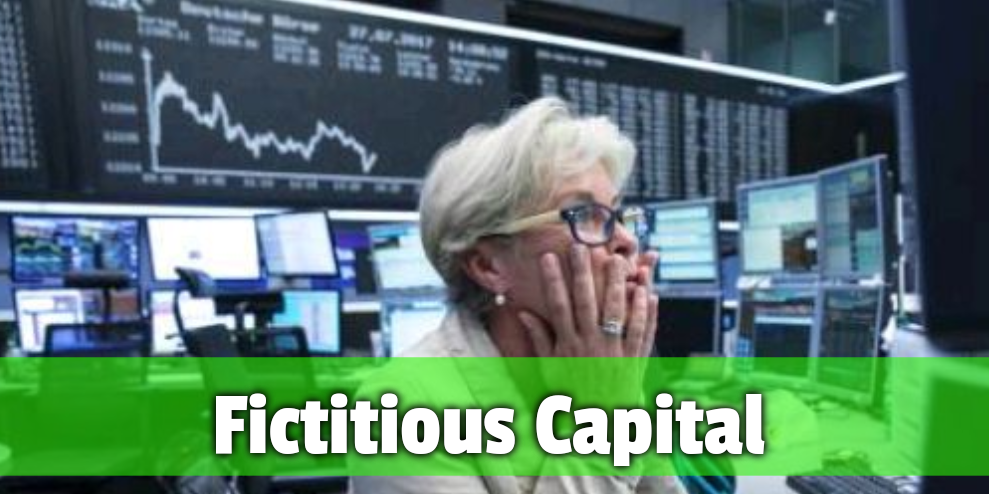Fictitious capital

Monetary capital that is not applied to production (of surplus value) but is reproduced parasitically in the form of a bet on the results of productive capital, a bet that will only give a positive overall result as long as the flow of fictitious capital towards speculative markets keeps growing.
Origins
During rising capitalism, fictitious capital already appeared as an outlet for a surplus of capital which regularly failed to find direct productive applications. It became the first speculative capital: the one that "found shelter" in national debt and in the Stock Exchange -speculating with the value of the companies without a real increase of the capital with which these operate. Being separated from the real production of surplus value, being nothing else in reality than money capital betting on the capacity of the state to collect a part of the produced surplus value (government debt) or on an increase of the future expectations on a company (stock market speculation).
Fictitious money capital is greatly diminished in crises, and with it the ability of its owners to obtain money from the market in return from it. But the fall in the nominal price of these securities in the price reports has nothing to do with the real capital they represent, although it does have a lot to do with the solvency of their owners.
Karl Marx. Capital. Section V. Chapter 30. Money capital and real capital.
Fictitious capital is already extremely fragile in the face of crises, since it depends on the increasing arrival of new fictitious capital in the market in order to reproduce itself with good returns, but this growth is produced as a symptom of the fact that accumulation has exceeded the limits in which it can be reinvested in the direct exploitation of labor. In other words, the more it grows and prospers, the weaker its foundations are and the more unlikely the global gamble to which it is applied is. That is why the great collapses of speculative markets are always abrupt and follow long periods of self-accelerated growth, the famous "bubbles".
What in rising capitalism was an important, although relatively marginal, phenomenon showing the permanent tendency of capital to over-accumulate, a trend that accelerated in the moments before the spasms in which the world market grows, with the entry into decadence turned into a central element of the financial system and the tool through which the "war capitalism" of the period 1914-18 became the current state capitalism.
The normal development of the industrial cycle was interrupted by war, which became the most powerful economic factor. The war created for the fundamental sectors of industry an almost unlimited market, totally shielded from all competition. The great buyer was never satisfied with what he was supplied with. The manufacture of the means of production was transformed into the manufacture of the means of destruction. Goods for personal consumption were purchased at ever-increasing prices by millions of individuals who produced nothing, who did nothing but destroy. This was the very process of destruction. But, by virtue of the monstrous contradictions of capitalist society, this ruin took the form of enrichment. The State issued loan after loan, issue after issue, and the budgets that were calculated in millions became calculated in billions. Machines and buildings were deteriorating and not being replaced. The land was badly cultivated. Essential buildings in the cities and on the railways were paralyzed. At the same time, the number of government securities, credit and treasury bonds and funds increased steadily. Fictitious capital grew as productive capital was destroyed. The credit system, a means of circulating goods, was transformed into a means of mobilizing national goods, including those to be created by future generations.
Fearing a crisis that would have been catastrophic, the capitalist state acted after the war in the same way it did during the war: new issues, new loans, purchase and sale price regulation of the most important items, guarantee of profits, products at reduced prices, multiple allocations added to wages and salaries... and with all this, military censorship and dictatorship of the officers.
Theses on the world situation and the tasks of the CI. Third Congress of the Communist International, June 1921.
After each imperialist world war, fictitious capital would undergo an exponential increase in the form of speculative markets and futures. Once the reconstruction was over, it became increasingly difficult for capital to find a place to sell all its production and thus to invest its accumulated wealth in new profitable applications. If there is no longer a market for almost everything it produces, how can there be a market to produce exponentially more? A part of the capital stopped looking for productive applications and was placed as a bet on the result of existing productive businesses, on the future demands of certain goods, on the payment of debt packages, etc. A gigantic mass of fictitious capital thus appeared, separated from the real exploitation of labor and therefore with feet of clay, which exceeded productive capital several times and was the trigger and cause of the sudden and catastrophic nature of financial crises.
http://dictionary.marxismo.school/Fictitious capital